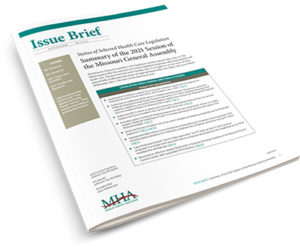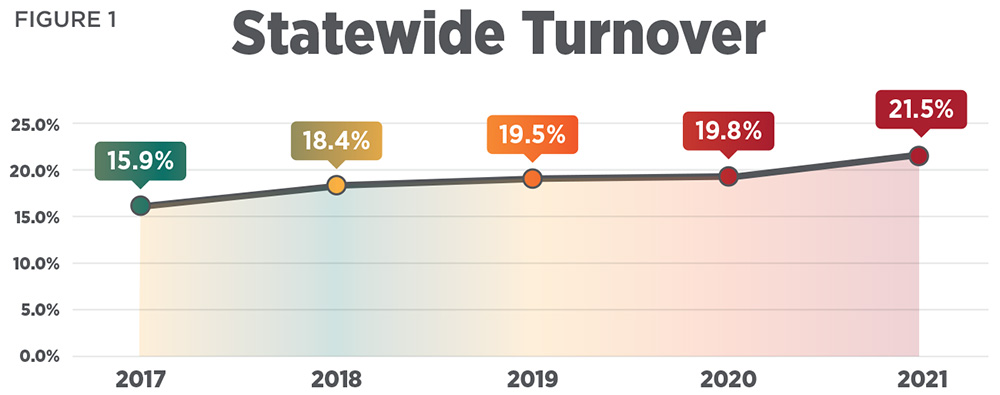
Summary Of The 2021 State Legislative Session
MHA Contact: Daniel Landon
The Missouri General Assembly’s 2021 legislative session ended May 14. MHA summarized the outcomes of many state legislative proposals affecting hospitals and health care.
A high-profile health care issue was whether state legislators would appropriate funds to implement the expansion of Medicaid eligibility standards that Missouri voters authorized at the ballot in August 2020. Legislative opposition largely focuses on concerns about the potential budgetary demands of expansion. In March 2021, Congress authorized strong financial incentives for Missouri and 13 other states to begin implementing Medicaid expansion. Even so, the General Assembly did not include explicit funding for Medicaid expansion in the state budget. It did set aside $500 million in a newly created “Medicaid Stabilization Fund” to enable spending not directly allocated in the Medicaid budget. As expected, a lawsuit is pending to clarify state government’s obligation to implement Medicaid expansion.
The legislature’s budget also incorporates the MO HealthNet Division’s new fee schedule for Medicaid hospital outpatient services. However, the necessary regulatory authorization will not be in place by the expected Thursday, July 1, start date; the division now anticipates implementation on Jan. 1, 2022. While the new outpatient fee schedule benefits some hospitals, it reduces payments to others. Responding to hospital concerns, the General Assembly appropriated $50 million to offset potential hospital losses from the payment change.
The state budget includes funding to support the projected increase in payments to hospitals for Medicaid services in fiscal year 2022, which begins July 1, 2021. It also includes an additional $258 million in Medicaid Disproportionate Share Hospital payments, implementing payment capacity enabled by successful litigation by MHA and others to change federal Medicaid DSH payment standards.
Beyond the state budget, legislators enacted a number of new laws affecting health care and hospitals. Resolving Missouri’s long-time status as the only state without a statewide prescription drug monitoring program, the General Assembly authorized one. It will replace the voluntary county-based system currently covering most Missourians. Responding to the rise of workplace violence in health settings, legislators created a new crime of “interference with a health care facility,” which encompasses various disruptions of hospital operations. Beginning Saturday, Aug. 28, a new law will limit health care providers’ liability in lawsuits related to COVID-19.
MHA’s legislative summary also describes legislative proposals that were not enacted, including various bills adverse to hospital operations. They also include reauthorization of the hospital Federal Reimbursement Allowance and other state provider taxes beyond their expiration of Thursday, Sept. 30. The provider taxes are used to fund Medicaid payments. Legislators are expected to return to Jefferson City to address the issue in a special session convened by the governor. The reauthorization is uncontroversial and universally acknowledged as necessary to avoid a state budget catastrophe. During the legislative session, the bill became entangled with debates of Medicaid coverage of abortion and family planning services.
2021 Workforce Report Finds Increased Vacancy And Turnover Rates
MHA Contact: Jill Williams
These are difficult times when it comes to health care staffing. Allocating personnel is a challenge even under normal circumstances, but with the COVID-19 pandemic stretching the system to its breaking point, achieving both efficiency and quality patient care requires hospitals and health systems to innovate workforce recruitment and retention efforts. Workforce investments contribute to an organization’s success through recruitment cost savings, reduced turnover, higher patient satisfaction and increased quality of care.
The data in MHA’s 2021 Workforce Report reflect the status of the hospital workforce in 2020, and thus reflect a COVID-19 workforce. A statewide analysis finds increased vacancy and turnover rates among a majority of the health care positions surveyed. The data indicate a combined turnover rate among all professions surveyed reached an all-time high at 21.5% statewide (Figure 1).

Staff nurses make up the largest number of hospital employees in Missouri. This year’s report finds a staff nurse vacancy of 12%. Staff nurse turnover increased 2% from 2020, which is the highest it’s been in the 20-year history of this survey at 18.1%. According to this survey, Missouri has 35,735 nurses working in hospitals and 4,894 vacant staff nurse positions.
It’s important for health care facilities to take a step back, reassess their labor needs, and develop a proactive response to staff recruitment and retention. The topic of workforce management in health care isn’t new, but COVID-19 surges brought attention to the need for hospitals to take a proactive approach.
There is tremendous potential for hospitals to foster stakeholder collaboration to address the gap between workforce supply and demand while expanding opportunities for incumbent employees to advance within health care career pathways. By using the lessons learned during the COVID-19 pandemic, hospitals — and partners in academia and workforce development — can transfer the best practices established during the pandemic to build a more robust hospital and health care workforce.
The report includes data from 131 hospitals and identifies trends among 28 hospital-based positions, and four clinic and physician practice positions. Also available are 10 regional reports and a report specific to Missouri’s critical access hospitals.
PAC Campaign Begins In June
MHA Contact: Christy Carel

MHA’s political action committee fundraising campaign is an important component of the association’s advocacy program. MHA supports three PACs — HEALTHPAC contributes to state-level candidates, AHAPAC is the PAC of the American Hospital Association that contributes to federal candidates and PAC of MHA also contributes to federal candidates. These PACs allow the hospital community to speak with one unified voice and support candidates who understand the complex issues hospitals tackle each and every day.
MHA’s 2021 fundraising campaign has a member-hospital goal of $100,000 for HEALTHPAC and $52,700 for AHAPAC. To meet this goal, it is essential for individuals from each member hospital, including hospital trustees, to participate. The 2021 campaign will kick off in early June, and we encourage you to contact your hospital CEO about participating.
Thank you for the important work you do on behalf of your hospital and community.
AHAPAC may accept contributions only from managerial employees, including trustees. Anyone may contribute to HEALTHPAC. Contributions are voluntary, and individuals are free to refuse to contribute without reprisal.

Board of Trustees Orientation Manual
MHA’s Board of Trustees Orientation Manual can be customized for your hospital. The document is a Microsoft Word template that enables you to quickly and easily add and delete content to modify the manual to fit your organization’s unique needs.

Roles & Responsibilities of Hospital Board Members
To remain engaged and successful in the leadership role, board members are encouraged to sharpen old skills and acquire new ones. This resource provides guidance on governance trends, barriers and best practices.

Sample Board Job Descriptions
MHA offers a sample job description for both a board chair and board member. Using the Microsoft Word template, these job descriptions can quickly and easily be modified to fit your organization's unique needs.
Education
Social Determinants of Health — Four-Part Virtual Series — June 8
As the focus of health care shifts from volume to value, health care organizations address social determinants of health during patient interactions to improve health outcomes while reducing costs. Each session is recorded and available to registered attendees after the session. Learn more.
Compliance: Board Accountability and Repercussions — June 16
Hospital and health care system boards have a fundamental, legal responsibility to provide oversight and accountability for the organization. Often referred to as the board’s fiduciary duty, the board’s responsibility is to foster resources to its constituents, and follow legal and ethical standards. Learn more.
On-Demand Education
The MHA Health Institute offers cost-effective learning opportunities for both members and nonmembers to help them understand and address emerging issues, learn and share best practices, and comply with legal and regulatory requirements. Learn more.









